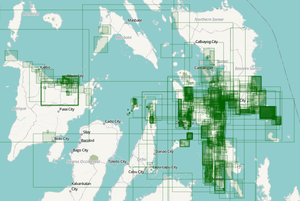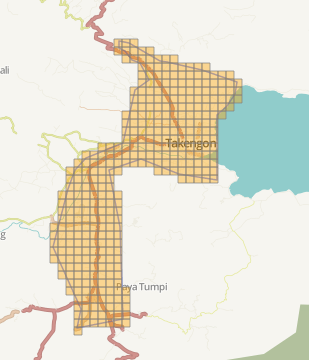Humanitarian OSM Team/Working groups/Activation/Activation Training
Activation training
Simulation exercise
| Tsunami (Scenario 3) | |
|
Tsunami The 2004 Indian Ocean earthquake occurred at 00:58:53 UTC on 26 December with an epicentre off the west coast of Sumatra, Indonesia. The event is known by the scientific community as the Sumatra–Andaman earthquake. The resulting tsunami was given various names, including the 2004 Indian Ocean tsunami, South Asian tsunami, Indonesian tsunami, the Christmas tsunami and the Boxing Day tsunami. The undersea megathrust earthquake was caused when the Indian Plate was subducted by the Burma Plate and triggered a series of devastating tsunamis along the coasts of most landmasses bordering the Indian Ocean, killing 230,000 people in 14 countries, and inundating coastal communities with waves up to 30 metres (100 ft) high.It was one of the deadliest natural disasters in recorded history. Indonesia was the hardest-hit country, followed by Sri Lanka, India, and Thailand. With a magnitude of Mw 9.1–9.3, it is the third-largest earthquake ever recorded on a seismograph. The earthquake had the longest duration of faulting ever observed, between 8.3 and 10 minutes. It caused the entire planet to vibrate as much as 1 centimetre (0.4 inches) and triggered other earthquakes as far away as Alaska. Its epicentre was between Simeulue and mainland Indonesia. The plight of the affected people and countries prompted a worldwide humanitarian response. In all, the worldwide community donated more than US$14 billion (2004) in humanitarian aid. | |
Map and Data Services
About OpenStreetMap
OpenStreetMap offers an online map (and spatial database) which is updated by the minute. Various tools and services allow data extracts for GIS specialists, Routable Garmin GPS data, Smartphone GPS navigation, and other device-compatible downloads. With an internet connection, regular syncing is possible with open access to the community contributed data as it comes in, with OpenStreetMap's bulk data downloads ideal for use offline. In addition, maps can also be printed to paper.
Browse the (example) Activation Area to get a feel for the data that is currently available. Different map styles including an Humanitarian style can be selected on the right side, and some data may not render (appear) on the map, but could be exported from the underlying database (See export section below).
Paper Maps
Poster size Maps and normal sized paper atlases of custom areas can be printed:
- FieldPapers Paper Maps with grid for field survey or general navigation purposes,
- MapOSMatic Large Paper Maps with grid, street index and POI, good for command centers, hospitals, etc.
Exporting OpenStreetMap data
See Downloading data for instructions on getting large scale map data. See Shapefiles if you need this format to export to GIS tools.
With the availibility of Small communication devices, Navigation Offline data proves to be very useful to the humanitarians deployed in foreign countries. We support the humanitarian NGO's using navigation data and invite them to give us feedback on the utilization of these devices in the context of field deployment. We can use OSMtracker (Android) to do offline road navigaton and OsmAnd as well
Usage of OSM data for Humanitarian Missions
About This Humanitarian (Mapping Project or) Activation
About HOT
- To learn more about the Humanitarian OpenStreetMap Team (HOT), explore more of our wiki-pages (root: HOT) or our website hotosm.org. We are a global community of mostly volunteers, we are also a US Nonprofit able to contract with organizations (email info at hotosm.org to contact our staff), we are also a 501-c-3 charitable organization.
History of this HMP/Activation
Reactivity of the OSM Community
- - describe activity before Activation here...
HOT Activates
- - describe activities post Activation here...
Tools, Adaptation and Services
The various OSM developers communicate over internet through various communication channels. In 2013 they implemented the new Humanitarian Map Style, a map more adapted to humanitarian actions. This map, hosted by OpenStreetMap - France, is integrated in various online map tools.
The Tasking Manager and the JOSM editor are essential parts of this Activation. As new imagery are available, new jobs are added to the Tasking Manager. It has allowed HOT to coordinate efforts of mappers around the world. Some days there were more then 200 simultaneous mappers registered on the Task Manager and editing mainly with the JOSM editor. Online editors are also used for less intensive mapping. LearnOSM offers learning material for beginners and more advanced mappers.
Coordination
Add the name(s) and optionally contact information for the HMP/Activation coordinator(s) here...
Support Team
Add additional person(s) assisting the HMP/Activation here...
Effort made
- Add statistics or links to data regarding mapping progress here...
For Mappers
- Example: HOT Coordinator(s) requesting remote mapping assistance for estimated 4 weeks mapping response
How You Can Contribute
Learn to Map
- Most of our volunteer needs are for remote OSM contributors, visit LearnOSM.org to get started.
- Add additional guidance for tagging in the HMP/Activation area here...
Mapping Priority
- Please choose from highest priority first
- Experienced mappers are also asked to participate in validating completed tasks. Information on validating can be found here
| Job No. | Priority | Location | What to map | Imagery Source | Task Mapping Status | Task Validation Status |
|---|---|---|---|---|---|---|
| Tasking No.1 | Low | Takengon | roads and residential | Landsat-8 | In Progress | In Progress |
Response maps
- Add links/examples of response maps for the area, here...
Available Imagery
Use this area to describe the availability and quality of imagery for the HMP/Activation area.
How to add to JOSM
It's easy to add special imagery to JOSM from the task manager jobs, where an imagery URL is provided within the task manager. Clicking the URL should trigger JOSM remote control to add the new imagery as a layer. For more details see OSM Tasking Manager/Setting up JOSM
Bing
Bing is the 'default' Imagery available for OSM (default option in most editors). Describe the Bing imagery coverage for the HMP/Activation area, alternative imagery sources may be provided in the Task Manager Jobs, and/or described below.
(Other Imagery Sources)
- Add sources and relevant information on imagery (broken into source) here...
Potential Datasources
Add potential data sources here...
Historical Maps
- Provide links to historical maps of the impacted area here...
Edit-a-thon events
- Add your event here...
Past Events
- Add past mapping events/projects in the impacted area here...
Other Links
- Provide relevant links here...
Edit the following categories (and remove this line) for your activation. [[Category:Humanitarian OSM Team |]] [[Category:Disasters|]] [[Category:|]]


